Archaeological discovery in Shiraz may rewrite city’s history

TEHRAN - A new archaeological discovery beneath a local park in Shiraz, the capital of Fars province in southern Iran, may push back the historical timeline of the ancient city by several thousand years.
The stone tools were first discovered on a site, known as “Tall-e Badi,” beneath layers of concrete and mosaic flooring during a park extension project, Mehr reported on Monday.
It was in February 2020 when an archaeology student, participating in the park’s development project, accidentally found stone tools and reported them to his professor at the University of Shiraz.
After initial examinations, both the professor and renowned archaeologist Alireza Askari Chaverdi, who is currently the director of the Persepolis and Naqsh-e Rustam historical sites, confirmed the historical significance of the findings.
According to Houshang Esfandiaripour, a prominent archaeologist in Fars province, the stone tools have been found around an electrical grounding pit, at a depth of 1.5 meters, indicating they were near the top of the ancient hill. He believes these artifacts could led the archaeologists to a period older than the 7,000-year-old Tell Pustchi, another archaeological site in Shiraz.
Esfandiaripour suggests that if deeper layers of the hill are excavated, there may be evidence of civilizations even older than previously thought, potentially pushing the history of Shiraz back by another two or three millennia. He compared the stone tools found in Tall-e Badi to those from the Bakun era, indicating that this site could predate Tall-e Pustchi, where similar artifacts were unearthed.
Efforts to have the site officially registered as a national heritage location have been unsuccessful. Despite its significance, the authorities have yet to recognize Tell Badi’s historical value. Esfandiaripour expressed frustration over the lack of action, noting that less significant sites have received national recognition.
As mentioned by the archaeologists, the discovery holds the potential to offer a rare glimpse into Shiraz’s ancient past, as much of the city’s historical landscape has been lost to urban development.
Archaeologists are eager to continue investigating the site, hoping it will yield evidence that could transform the historical narrative of Shiraz and the surrounding Fars region.
Celebrated as the heartland of Persian culture for over 2000 years, Shiraz has become synonymous with education, nightingales, poetry, and crafts skills passed down from generation to generation. It was one of the most important cities in the medieval Islamic world and was the Iranian capital during the Zand dynasty from 1751 to 1794.
Shiraz is home to some of the country’s most magnificent buildings and sights. Increasingly, it draws more and more foreign and domestic sightseers flocking to this provincial capital.
Eram Garden, Afif-Abad Garden, Tomb of Hafez, Tomb of Sa’di, Jameh Mosque of Atigh, and Persepolis are among the historical, cultural, and ancient sites of Shiraz that are of interest to domestic and foreign tourists.
The ancient city is also home to some magnificent historical gardens such as Bagh-e Narenjestan and Eram Garden, which are top tourist destinations both for domestic and international sightseers.
AM
